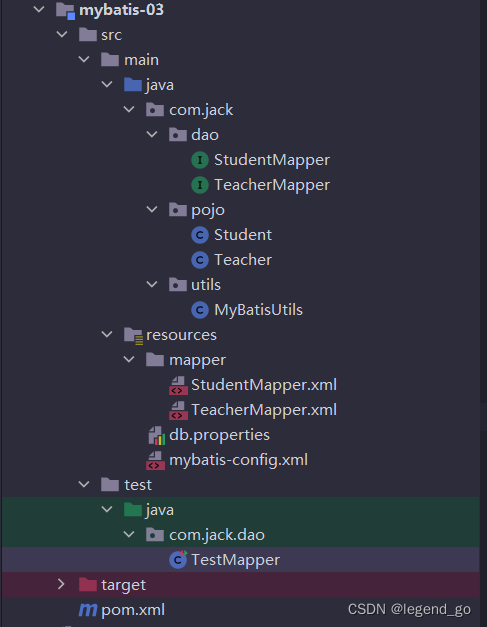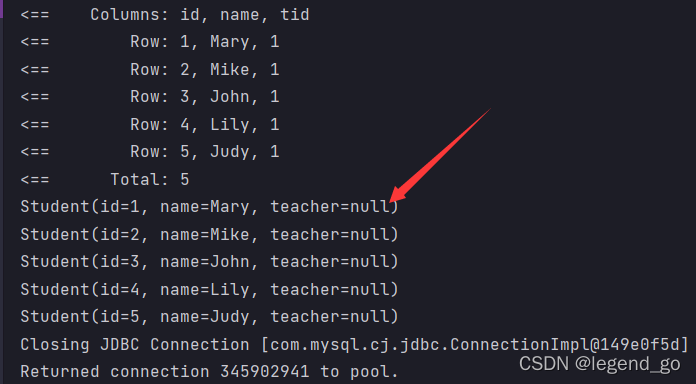MyBatis-04
一、复杂查询环境搭建
重复的文件从之前搭建好的拿就行😁,在此不再赘述
1、首先创建两个表(teacher表,student表):
DROP TABLE IF EXISTS `teacher`;
DROP TABLE IF EXISTS `student`;
CREATE TABLE `teacher` (
`id` bigint NOT NULL PRIMARY KEY,
`name` varchar(30) DEFAULT NULL
)ENGINE=INNODB DEFAULT CHARSET=utf8;
INSERT INTO teacher (id, name) VALUES (1,'Jack');
CREATE TABLE `student` (
`id` bigint NOT NULL PRIMARY KEY,
`name` varchar(30) DEFAULT NULL,
`tid` bigint NOT NULL
)ENGINE=INNODB DEFAULT CHARSET=utf8;
INSERT INTO student (id, name, tid) VALUES (1,'Mary',1);
INSERT INTO student (id, name, tid) VALUES (2,'Mike',1);
INSERT INTO student (id, name, tid) VALUES (3,'John',1);
INSERT INTO student (id, name, tid) VALUES (4,'Lily',1);
INSERT INTO student (id, name, tid) VALUES (5,'Judy',1);
SELECT * FROM student, teacher;
2、构建实体类(Student,Teacher):
Student实体类:
@Data
public class Student {
private long id;
private String name;
private Teacher teacher;
}
Teacher实体类:
@Data
public class Teacher {
private long id;
private String name;
}
3、编写数据访问层接口(StudentMapper,TeacherMapper):
StudentMapper接口:
public interface StudentMapper {
@Select("select * from student")
List<Student> getStudentList();
}
TeacherMapper接口:
public interface TeacherMapper {
@Select("select * from teacher")
List<Teacher> getTeacherList();
}
4、构造*Mapper.xml文件:
StudentMapper.xml:
<?xml version="1.0" encoding="UTF-8" ?>
<!DOCTYPE mapper
PUBLIC "-//mybatis.org//DTD Config 3.0//EN"
"http://mybatis.org/dtd/mybatis-3-mapper.dtd">
<mapper namespace="com.jack.dao.StudentMapper">
</mapper>
TeacherMapper.xml:
<?xml version="1.0" encoding="UTF-8" ?>
<!DOCTYPE mapper
PUBLIC "-//mybatis.org//DTD Config 3.0//EN"
"http://mybatis.org/dtd/mybatis-3-mapper.dtd">
<mapper namespace="com.jack.dao.TeacherMapper">
</mapper>
5、在config文件中配置mapper映射器:
<mappers>
<package name="com.jack.dao"/>
</mappers>
6、单元测试保证环境搭建成功:
TestMapper:
public class TestMapper {
public static void main(String[] args) {
SqlSession sqlSession = MyBatisUtils.getSqlSession();
TeacherMapper mapper = sqlSession.getMapper(TeacherMapper.class);
List<Teacher> teacherList = mapper.getTeacherList();
for (Teacher teacher : teacherList) {
System.out.println(teacher);
}
sqlSession.close();
}
@Test
public void testGetStudentList(){
SqlSession sqlSession = MyBatisUtils.getSqlSession();
StudentMapper mapper = sqlSession.getMapper(StudentMapper.class);
List<Student> studentList = mapper.getStudentList();
for (Student student : studentList) {
System.out.println(student);
}
sqlSession.close();
}
}
至此文件结构如下:

二、多对一处理
如果上一步环境搭建成功的话,那么就是多对一的关系(多名学生对应一位老湿)
1、单元测试:
现在如果直接进行单元测试的话,就会出现如下情况:

2、问题分析:
看到这个结果我们第一时间想到的应该是利用ResultMap进行结果集映射,但是teacher字段是对象类型,如何进行映射呢?
其实,MyBatis已经提供了两种映射属性:association属性以及collection属性,其中association属性符合多对一的情况下的结果映射,collection属性符合之后会叙述的一对多的情况
3、问题处理:
有两种方式进行解决:
- 查询嵌套
- 结果嵌套
(1)、查询嵌套:
<!--结果映射1 查询嵌套-->
<select id="getStudentList" resultMap="StudentTeacher">
select * from test.student
</select>
<resultMap id="StudentTeacher" type="Student">
<result property="id" column="id"/>
<result property="name" column="name"/>
<association property="teacher" column="tid" javaType="Teacher" select="getTeachers"/>
</resultMap>
<select id="getTeachers" resultType="Teacher">
select * from test.teacher where id = #{id}
</select>
(2)、结果嵌套:
<!--结果映射2 结果嵌套-->
<select id="getStudentList2" resultMap="TeacherStudent">
select s.id sid, s.name sname, t.name tname
from student s,teacher t
where s.tid = t.id
</select>
<resultMap id="TeacherStudent" type="Student">
<result property="id" column="sid"/>
<result property="name" column="sname"/>
<association property="teacher" javaType="Teacher">
<result property="name" column="tname"/>
</association>
</resultMap>
4、单元测试
@Test
public void testGetStudentList(){
SqlSession sqlSession = MyBatisUtils.getSqlSession();
StudentMapper mapper = sqlSession.getMapper(StudentMapper.class);
List<Student> studentList = mapper.getStudentList();
for (Student student : studentList) {
System.out.println(student);
}
sqlSession.close();
}
@Test
public void testGetStudentList2(){
SqlSession sqlSession = MyBatisUtils.getSqlSession();
StudentMapper mapper = sqlSession.getMapper(StudentMapper.class);
List<Student> studentList = mapper.getStudentList2();
for (Student student : studentList) {
System.out.println(student);
}
sqlSession.close();
}
三、一对多处理:
1、创建实体类:
Student实体类:
@Data
public class Student {
private long id;
private String name;
private long tid;
// private Teacher teacher;
}
Teacher实体类:
@Data
public class Teacher {
private long id;
private String name;
private List<Student> students;
}
2、编写数据访问层接口(TeacherMapper):
TeacherMapper接口:
public interface TeacherMapper {
List<Teacher> getTeacher(@Param("tid") long id);
List<Teacher> getTeacher2(@Param("tid") long id);
}
3、构造TeacherMapper.xml文件:
TeacherMapper.xml:
<?xml version="1.0" encoding="UTF-8" ?>
<!DOCTYPE mapper
PUBLIC "-//mybatis.org//DTD Config 3.0//EN"
"http://mybatis.org/dtd/mybatis-3-mapper.dtd">
<mapper namespace="com.jack.dao.TeacherMapper">
<!--结果映射1 查询嵌套-->
<select id="getTeacher" resultMap="StudentTeacher">
select * from test.teacher where id = #{tid}
</select>
<resultMap id="StudentTeacher" type="Teacher">
<collection property="students" javaType="ArrayList" ofType="Student" select="getStudents" column="id"/>
</resultMap>
<select id="getStudents" resultType="Student">
select * from test.student where tid = #{id}
</select>
<!--结果映射2 结果嵌套-->
<select id="getTeacher2" resultMap="TeacherStudent">
select s.id sid, s.name sname, t.name tname,t.id tid
from student s,teacher t
where s.tid = t.id and t.id = #{tid}
</select>
<resultMap id="TeacherStudent" type="Teacher">
<result property="id" column="tid"/>
<result property="name" column="tname"/>
<collection property="students" ofType="Student">
<result property="id" column="sid"/>
<result property="name" column="sname"/>
<result property="tid" column="tid"/>
</collection>
</resultMap>
</mapper>
单元测试:
public class TestMapper {
public static void main(String[] args) {
SqlSession sqlSession = MyBatisUtils.getSqlSession();
TeacherMapper mapper = sqlSession.getMapper(TeacherMapper.class);
List<Teacher> teacherList = mapper.getTeacher(1);
for (Teacher teacher : teacherList) {
System.out.println(teacher);
}
sqlSession.close();
}
@Test
public void testGetTeacher2(){
SqlSession sqlSession = MyBatisUtils.getSqlSession();
TeacherMapper mapper = sqlSession.getMapper(TeacherMapper.class);
List<Teacher> teacherList = mapper.getTeacher2(1);
for (Teacher teacher : teacherList) {
System.out.println(teacher);
}
sqlSession.close();
}
}
四、动态SQL环境搭建
首先创建一个表用于测试:
DROP TABLE IF EXISTS `blog`;
CREATE TABLE `blog` (
`id` BIGINT NOT NULL PRIMARY KEY COMMENT '博客ID',
`title` VARCHAR(30) DEFAULT NULL COMMENT '博客标题',
`author` VARCHAR(30) DEFAULT NULL COMMENT '博客作者',
`created_time` DATETIME NOT NULL COMMENT '创建时间',
`views` INT(30) NOT NULL COMMENT '访问量'
)ENGINE = INNODB DEFAULT CHARSET = UTF8;
INSERT INTO blog
(id, title, author, created_time, views)
VALUES (1,'Java从入门到放弃','jack','2020-02-14',4433);
INSERT INTO blog
(id, title, author, created_time, views)
VALUES (2,'Java从入门到起飞','MATY','2020-02-14',123);
INSERT INTO blog
(id, title, author, created_time, views)
VALUES (3,'Java从起飞到放弃','lili','2020-02-14',1098);
INSERT INTO blog
(id, title, author, created_time, views)
VALUES (4,'Maven入门','jk','2020-02-14',344);
INSERT INTO blog
(id, title, author, created_time, views)
VALUES (5,'MyBats使用','json','2020-02-14',100);
SELECT * FROM blog
重复配置文件不再赘述
1、构建实体类
@Data
public class Blog {
private long id;
private String title;
private String author;
private Date createdTime;
private int views;
}
2、构建Mapper接口:
public interface BlogMapper {
@Select("select * from blog")
List<Blog> getBlogList();
List<Blog> getBlogs(Map map);
}
3、构建BlogMapper.xml文件:
<?xml version="1.0" encoding="UTF-8" ?>
<!DOCTYPE mapper
PUBLIC "-//mybatis.org//DTD Config 3.0//EN"
"http://mybatis.org/dtd/mybatis-3-mapper.dtd">
<mapper namespace="com.jack.dao.BlogMapper">
</mapper>
4、注册Mapper映射文件:
<mappers>
<mapper resource="mapper/BlogMapper.xml"/>
</mappers>
5、单元测试保证环境搭建成功:
public class TestMapper {
public static void main(String[] args) {
SqlSession sqlSession = MyBatisUtils.getSqlSession();
BlogMapper mapper = sqlSession.getMapper(BlogMapper.class);
List<Blog> blogList = mapper.getBlogList();
for (Blog blog : blogList) {
System.out.println(blog);
}
sqlSession.close();
}
}
一、IF标签使用:
Mapper文件:
<select id="getBlogs" parameterType="map" resultType="Blog">
select * from blog where 1=1
<if test="title != null">
and title = #{title}
</if>
<if test="author != null">
and author = #{author}
</if>
</select>
更标准的写法:
<?xml version="1.0" encoding="UTF-8" ?>
<!DOCTYPE mapper
PUBLIC "-//mybatis.org//DTD Config 3.0//EN"
"http://mybatis.org/dtd/mybatis-3-mapper.dtd">
<mapper namespace="com.jack.dao.BlogMapper">
<select id="getBlogs" parameterType="map" resultType="Blog">
select * from blog
<where>
<if test="title != null">
and title = #{title}
</if>
<if test="author != null">
and author = #{author}
</if>
</where>
</select>
</mapper>
单元测试:
@Test
public void testGetBlogByIfLabel(){
SqlSession sqlSession = MyBatisUtils.getSqlSession();
BlogMapper mapper = sqlSession.getMapper(BlogMapper.class);
HashMap<Object, Object> map = new HashMap<>();
// map.put("title","Maven入门");
// map.put("author","jack");
List<Blog> blogList = mapper.getBlogs(map);
for (Blog blog : blogList) {
System.out.println(blog);
}
sqlSession.close();
}
输出:

去掉一行注释再进行单元测试:
@Test
public void testGetBlogByIfLabel(){
SqlSession sqlSession = MyBatisUtils.getSqlSession();
BlogMapper mapper = sqlSession.getMapper(BlogMapper.class);
HashMap<Object, Object> map = new HashMap<>();
map.put("title","Maven入门");
// map.put("author","jack");
List<Blog> blogList = mapper.getBlogs(map);
for (Blog blog : blogList) {
System.out.println(blog);
}
sqlSession.close();
}
输出:
![[外链图片转存失败,源站可能有防盗链机制,建议将图片保存下来直接上传(img-xpU7zeYl-1645109230023)(C:\Users\Lenovo\AppData\Roaming\Typora\typora-user-images\image-20220217214839855.png)]](https://img-blog.csdnimg.cn/ed1826263f684b34a1dfad3fba72d863.png?x-oss-process=image/watermark,type_d3F5LXplbmhlaQ,shadow_50,text_Q1NETiBAbGVnZW5kX2dv,size_20,color_FFFFFF,t_70,g_se,x_16)
试着再删除一行注释再进行单元测试:
@Test
public void testGetBlogByIfLabel(){
SqlSession sqlSession = MyBatisUtils.getSqlSession();
BlogMapper mapper = sqlSession.getMapper(BlogMapper.class);
HashMap<Object, Object> map = new HashMap<>();
// map.put("title","Maven入门");
map.put("author","jack");
List<Blog> blogList = mapper.getBlogs(map);
for (Blog blog : blogList) {
System.out.println(blog);
}
sqlSession.close();
}
输出:
![[外链图片转存失败,源站可能有防盗链机制,建议将图片保存下来直接上传(img-433QmAgv-1645109230023)(C:\Users\Lenovo\AppData\Roaming\Typora\typora-user-images\image-20220217214944551.png)]](https://img-blog.csdnimg.cn/35614d4518d14980bb39d54a3f3359ae.png?x-oss-process=image/watermark,type_d3F5LXplbmhlaQ,shadow_50,text_Q1NETiBAbGVnZW5kX2dv,size_20,color_FFFFFF,t_70,g_se,x_16)
PS:where 元素只会在子元素返回任何内容的情况下才插入 “WHERE” 子句。而且,若子句的开头为 “AND” 或 “OR”,where 元素也会将它们去除。
二、CHOOSE、WHEN、OTHERWISE标签使用:
Mapper文件:
<select id="getBlogs2" parameterType="map" resultType="Blog">
select * from blog
<where>
<choose>
<when test="title != null">
title = #{title}
</when>
<when test="author != null">
and author = #{author}
</when>
<otherwise>
and views = #{views}
</otherwise>
</choose>
</where>
</select>
Mapper接口:
public interface BlogMapper {
@Select("select * from blog")
List<Blog> getBlogList();
List<Blog> getBlogs(Map map);
List<Blog> getBlogs2(Map map);
}
单元测试:
@Test
public void testGetBlogByChooseLabel(){
SqlSession sqlSession = MyBatisUtils.getSqlSession();
BlogMapper mapper = sqlSession.getMapper(BlogMapper.class);
HashMap<Object, Object> map = new HashMap<>();
// map.put("title","Maven入门");
// map.put("author","jack");
map.put("views","999");
List<Blog> blogList = mapper.getBlogs2(map);
for (Blog blog : blogList) {
System.out.println(blog);
}
sqlSession.close();
}
输出结果同IF标签,也就是在otherwise哪里不同:
![[外链图片转存失败,源站可能有防盗链机制,建议将图片保存下来直接上传(img-MuhX9yVv-1645109230024)(C:\Users\Lenovo\AppData\Roaming\Typora\typora-user-images\image-20220217215940364.png)]](https://img-blog.csdnimg.cn/abf27833807d498eb318131706befa4d.png)
三、SET标签使用:
Mapper文件:
<update id="updateBlog" parameterType="blog">
update blog
<set>
<if test="title != null">
title = #{title},
</if>
<if test="author != null">
author = #{author},
</if>
<if test="views != null">
views = #{views},
</if>
</set>
where id = #{id}
</update>
Mapper接口:
int updateBlog(Blog blog);
单元测试:
@Test
public void testUpdateBlog(){
SqlSession sqlSession = MyBatisUtils.getSqlSession();
BlogMapper mapper = sqlSession.getMapper(BlogMapper.class);
mapper.updateBlog(new Blog(2,"SpringBoot开源代码",null,null,333));
sqlSession.close();
}
输出:

数据库信息:

四、ForEach标签使用:
Mapper文件:
<select id="queryBlogByForEachLabel" parameterType="map" resultType="blog">
select * from blog
<where>
<foreach collection="ids" item="id" index="index" open="and (" separator="or" close=")">
id = #{id}
</foreach>
</where>
</select>
Mapper接口:
List<Blog> queryBlogByForEachLabel(Map map);
单元测试:
@Test
public void testQueryBlogByForEach(){
SqlSession sqlSession = MyBatisUtils.getSqlSession();
BlogMapper mapper = sqlSession.getMapper(BlogMapper.class);
HashMap<Object, Object> map = new HashMap<>();
ArrayList<Object> ids = new ArrayList<>();
ids.add(1);
map.put("ids",ids);
List<Blog> blogList = mapper.queryBlogByForEachLabel(map);
for (Blog blog : blogList) {
System.out.println(blog);
}
sqlSession.close();
}
输出:

小插曲:Sql公共代码段使用:
Mapper文件:
<!-- Set标签-->
<update id="updateBlog" parameterType="blog">
update blog
<set>
<include refid="publicCodeBlock"></include>
</set>
where id = #{id}
</update>
<!-- Sql代码块-->
<sql id="publicCodeBlock">
<if test="title != null">
title = #{title},
</if>
<if test="author != null">
author = #{author},
</if>
<if test="views != null">
views = #{views},
</if>
</sql>
作用:降低代码复用,但是只能包含简单语句,不建议插入复杂语句
总Mapper文件(仅供参考):
<?xml version="1.0" encoding="UTF-8" ?>
<!DOCTYPE mapper
PUBLIC "-//mybatis.org//DTD Config 3.0//EN"
"http://mybatis.org/dtd/mybatis-3-mapper.dtd">
<mapper namespace="com.jack.dao.BlogMapper">
<!-- if标签-->
<select id="getBlogs" parameterType="map" resultType="Blog">
select * from blog
<where>
<if test="title != null">
and title = #{title}
</if>
<if test="author != null">
and author = #{author}
</if>
</where>
</select>
<!-- choose以及when还有otherwise标签-->
<select id="getBlogs2" parameterType="map" resultType="Blog">
select * from blog
<where>
<choose>
<when test="title != null">
title = #{title}
</when>
<when test="author != null">
and author = #{author}
</when>
<otherwise>
and views = #{views}
</otherwise>
</choose>
</where>
</select>
<!-- Set标签-->
<update id="updateBlog" parameterType="blog">
update blog
<set>
<include refid="publicCodeBlock"></include>
</set>
where id = #{id}
</update>
<!-- ForEach标签-->
<select id="queryBlogByForEachLabel" parameterType="map" resultType="blog">
select * from blog
<where>
<foreach collection="ids" item="id" index="index" open="and (" separator="or" close=")">
id = #{id}
</foreach>
</where>
</select>
<!-- Sql代码块-->
<sql id="publicCodeBlock">
<if test="title != null">
title = #{title},
</if>
<if test="author != null">
author = #{author},
</if>
<if test="views != null">
views = #{views},
</if>
</sql>
</mapper>
相关文章:
- 什么是MyBatis
- 为什么要用MyBatis
- 如何使用MyBatis?
- 增删改查实现
- Map以及模糊查询
- 配置属性优化
- 配置别名优化
- 配置映射器说明
- 生命周期以及作用域
- ResultMap结果集映射
- 日志实现
- 分页实现
- 注解开发
- MyBatis执行流程
- 通过注解实现增删改查
- LomBok使用
- 缓存简介
- 一级缓存
- 二级缓存
- MyBatis缓存原理